Rock gardens are a practical way to use hostas because hostas can thrive in rocks and hostas in the wild are frequently associated with rocks. Rock gardens also require little care and hostas work well as a low-maintenance garden.
Hostas are drought-tolerant, robust, and shade-loving plants. They can live in zones 3-9 with over 70 species and 3,000+ hybrids.
The possibilities are endless. Hostas and rocks are a sensible combination because of the hosta’s need for well-drained soil and, when planted in a rock garden, create a low maintenance garden.
Wondering how and why you should plant hostas in your rock garden? Whether you are creating a rock garden from scratch or just adding a few hostas, you can use some of our tips and tricks to use your hostas and rocks to their fullest potential.
Let’s be Practical – Hard Work – Low Maintenance
Rock gardens and hostas work very well together because of their low maintenance, adaptability, and complementary colors. Let’s break this down.
The rocks in rock gardens themselves can fight off weeds by creating a sturdier layer of protection than wood mulch. Staying on top of the weeds, especially in the beginning, is a must, but overall, there is less weeding than using wood mulch.
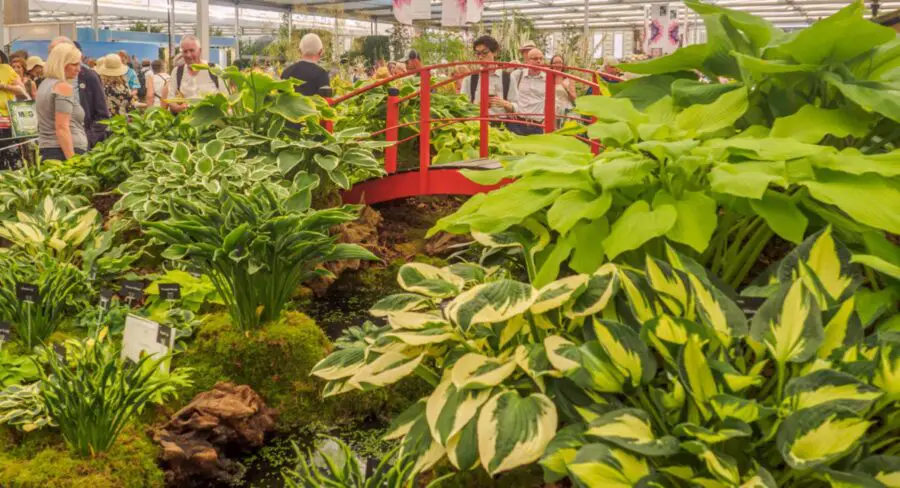
Now let’s add hostas into the mix. If appropriately planned, the mature hostas will create another layer of protection.
Plant the hostas with the proper spacing that will allow the leaves if the mature hostas to touch. Not letting sunlight to reach the ground is important as most weeks need sunlight to germinate.
The adaptability of rock gardens comes into play when thinking about things like paths, accents to fountains or significant features in the yard, or hills and slopes.
The beauty of rocks is the ability to create their own retainers by stacking on top of each other or merely placing larger ones as borders.
Video: Rock Garden Tour – Shade Garden Ideas – Rock Garden Ideas
The adaptability of hostas is just as equally impressive. The fact they are shade-loving allows for almost any space in your yard to become a garden. Do not let this fool you hostas are tough, and many varieties will do perfectly well with more sun.
Rock gardens have a natural feel to them when done right. The earthy tones, the depth of various rocks, and the unique number of shapes a rock garden can be.
Having many contrasting colored rocks or even types of rock will break the natural look of a rock garden.
When setting up rocks, a rule of thumb to go from large to small. This will help with not overcrowding the large rocks.
Be creative when making a rock garden; I do not mean them to be raised square planting beds. I listed some ideas above. Also, use them to your advantage if your yard is sloped or has an area that acts as a water funnel. We can use them as little river beds.
Hostas have such vibrant and a multitude of deep colors.
Be careful about having too many kinds of hostas. Doing so can look chaotic and less natural.
Using hostas as a border around the rock garden is a great idea, keeping them to one species or at least under three is a good idea.
What Kind of Rock Will You Use in Your Rock Garden
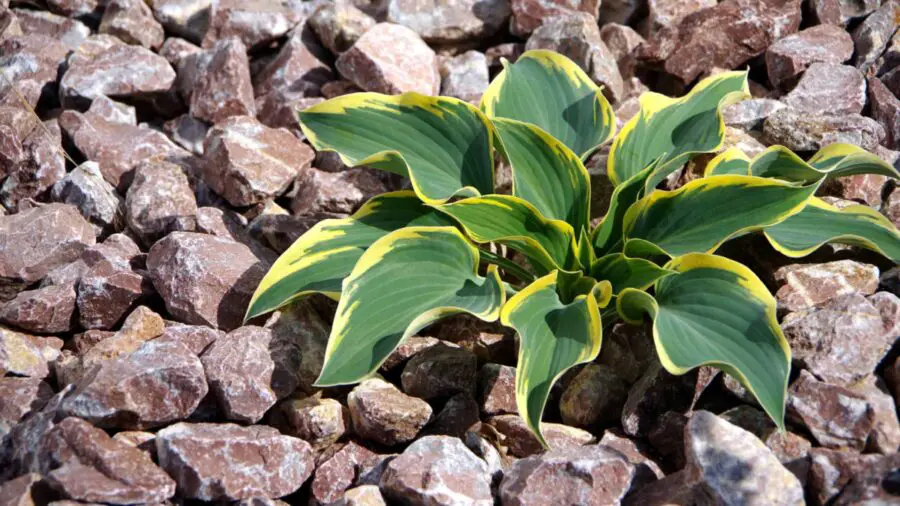
here are two ways to go about a rock garden, starting from scratch or using what you have. A chart of various rocks, sizes, drainage abilities, and price are further below.
In the meantime, let’s discuss a simple rock garden using one or two types of smaller rock to a more complicated rock garden with multiple types and sizes of rocks.
There are many ways to plant hostas in rocks. My first suggestion is to work with what you have. Below is a short list of standard gravel mulch used in a rock garden.
Pea Gravel
Lava Rock
Brick Chips
Crushed Granite Gravel
River Rock
Marble Chips
Using one of these rocks is what a simpler rock garden would look like, with a possibly larger river rock or stone bordering the outside. Matching the environment can help determine what rocks you should use; this will create a natural feel to your garden.
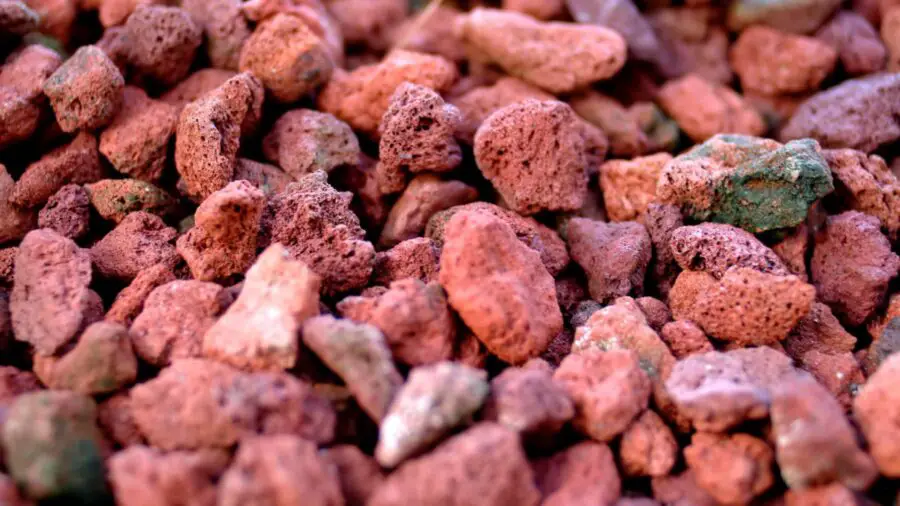
A more complex rock garden will have larger rocks within them. They will usually have things like retaining walls of dry laid rocks, rocks stacked aesthetically, or create mounds to be planted on, and using rocks to create patterns. Either way, here are some extra rocks typically used.
Large River Rocks
Flagstone
Boulders
When making a rock garden, decomposed granite can be an important addition. Decomposed granite is a fine crushed stone resembling coarse sand.
I add it to the rock garden to mimic wood chips. It will provide nutrients such as calcium, magnesium, and iron; it will also hold moisture.
Hostas in Rock Gardens – So Many Choices
We will get into the how-to of designing the overall garden, but it is crucial to explain the how-to of planting and selecting the right hostas.
The chart below shows various types of hostas as well as mature sizes, and the amount of sun needed for each variety of hosta. What we will go over now are some tips and tricks for growing hostas.
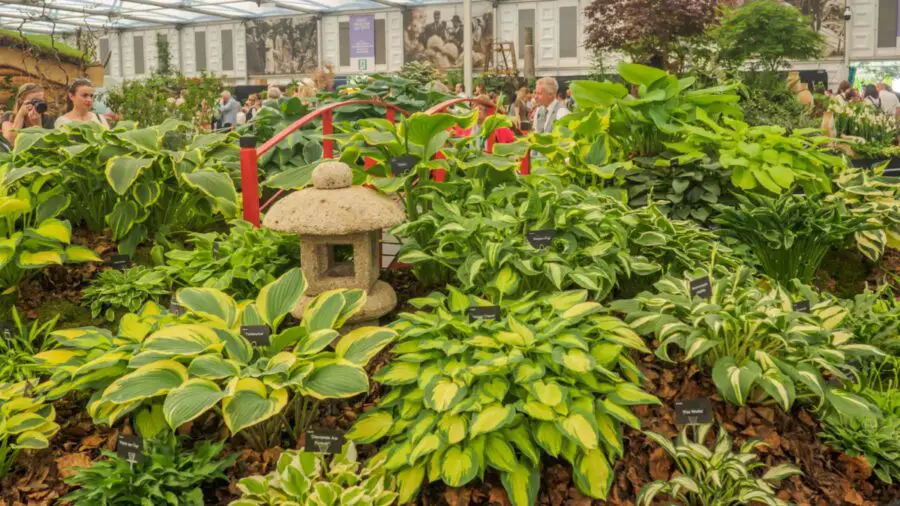
It’s important to differentiate between the morning sun and the harsher afternoon sun. The afternoon sun will come with a lot more heat. This is when the burnt-looking edges of your hosta will come into play.
f you are worried about getting too much afternoon sun in an area, choose lighter shades of rocks they will hold and reflect less heat than the darker shades.
Work with the sun by watching as the sun goes over your yard. Mark or remember where the most sun and shade is, plant according to the hostas’ needs.
Work with rocks and hills, South-facing slopes or the South sides of large rocks will get more sun while the North-facing side will get more shade.
Plant at least four weeks before the first frost, usually August, or after the last frost, at the end of May.
The ideal soil pH for hostas is between 6.5-7.5
If plants start showing browning on the edges or dull leaf colors, they need to move to a shadier area.
We can group hostas into five sizes, miniature under 10 inches, small 10-15 inches, medium 15-25 inches, large 25-30 inches, and giant 30 plus inches. Use the various dimensions to create shade or give more sun to plants that need it.
Hostas like at least four hours of morning sunlight with diffused sunlight throughout the day, this would be like shade under a tree not from a brick wall, but remember they are tough plants; this is not a necessity.
Let’s Put it All Together – Sit Back and Watch it Grow
As I mentioned above, natural looks for rock gardens are key to success. Mimicking the rocks in your area is a great idea.
When placing rocks, bury them a third of their height in the ground. This will prevent the frost from dislodging them and help give you that natural look.
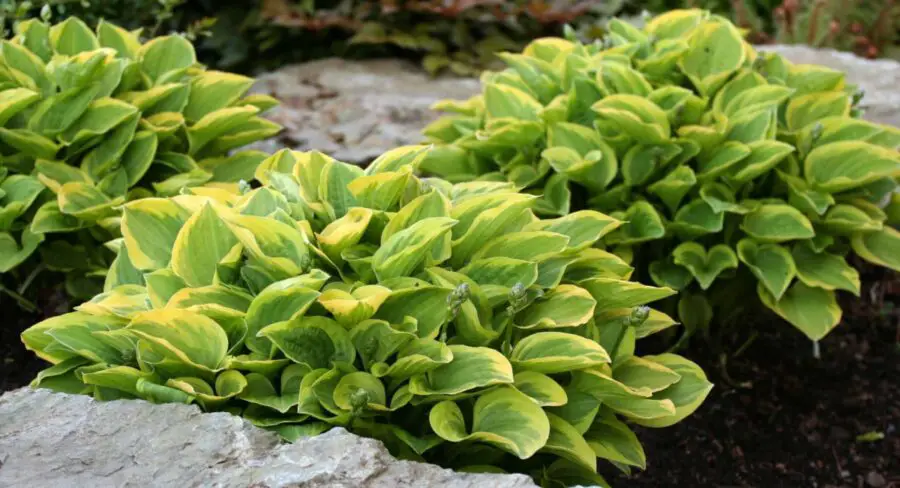
The striation of the rocks should go in the same general direction.
Stacking rocks to form a small retaining wall can help get the hostas closer to eye level, showing off their beautiful leaves.
[table id=2 responsive=scroll /]
There is always worry in the first spring that your hostas are not coming up because you have done something wrong planting the garden. The link above my calm some of your worries.
What type of hostas you prefer. Are your favorite hostas sun seekers or sun shy like many blue hostas. If you have the luxury of picking the spot for your garden, try matching the light conditions that which your favorites’ wants.
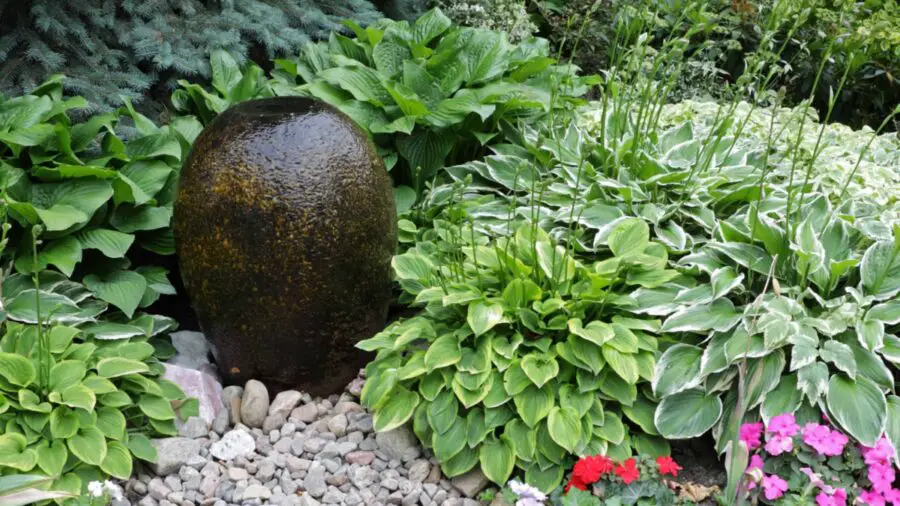
Then place the garden accordingly with a layer of sand or decomposed granite, topsoil, then Peat moss for shade-loving plants put a high nutrient compost, then Peat moss under the rocks.
You might wonder what to do if your hostas are not flowering as you wanted them to or not like the pictures. If the perfect garden bed is in an area where you are worried and do not get enough shade, consider this.
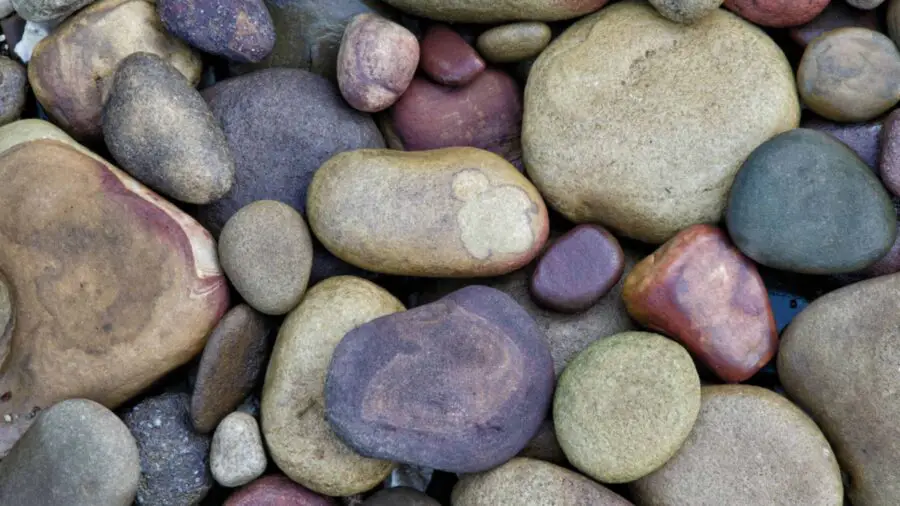
While shade seems essential for the production of the large expanses of hosta leaves, they may require more sun to produce good flowers.
Many hostas will grow in a great deal more sunlight than the conditions in which they are normally planted, provided they receive sufficient moisture at the roots,” Diana Grenfell and Micheal Shadrack’s book The New Encyclopedia of Hostas.
Here are some categories and examples you should look into before buying your hostas for your rock garden.
[table id=1 responsive=scroll /]
Remember, these plants are tough, and they will be fine with direct sunlight as long as they get diffused sunlight throughout the day. If the leaves turn dull, this is a good indicator; it’s not getting enough sun.
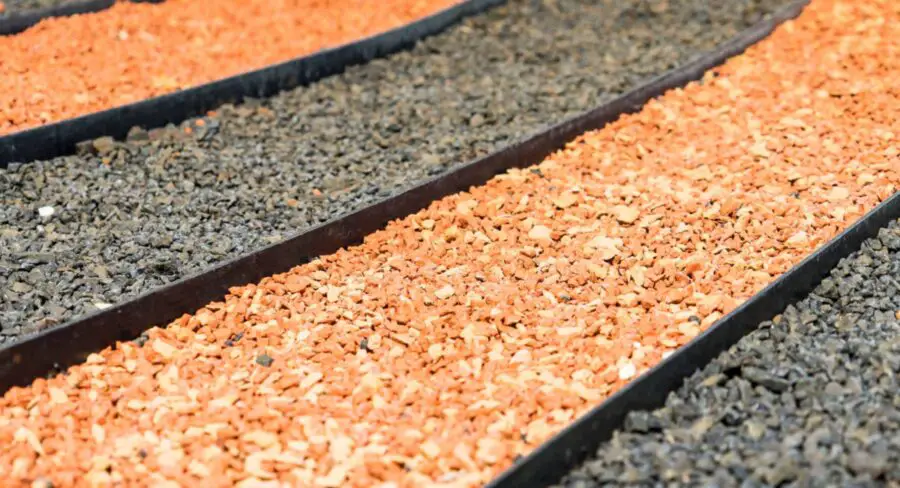
Now consider the rocks you can work with when creating a rock garden. Don’t be afraid to find your rocks down by the river or in the backyard; these types of weathered stones and rocks are something you cannot buy in stores.
Related Questions
Can you apply fertilizer to a rock garden
es, dry granular fertilizer will work well. If possible, a very light rake will help the fertilizer fall to the soil. For detailed information on fertilizing hostas, check our post How to Use Hosta Fertilizer to Keep Your Hostas Beautiful.
Where else are suitable areas to create a rock garden
Fruit trees do exceptionally well with gravel mulch, and the diffused sunlight will be great for a few hostas. Top off pots too; a gravel mulch will help contain moisture.
Can you plant hostas with roses
Yes, you can. With careful planning and a little skill, you can have a rose and hosta garden. And of course, we have an article all about planting hostas and roses together.
Video: DIY Rock Landscaping Idea | River Rock
Let’s Wrap it Up
Rocks can give you a great canvas to use the perfect paint, hostas. The drought-tolerant perennial will be a low-maintenance pair to your rocks. Create your unique rock garden and do not forget that hostas in rock gardens are beautiful.
We have talked about natural rock gardens. However, if you prefer formal rock gardens, hostas are still a great accent plant.
Please watch the videos, as they are full of tips that will help you succeed.
